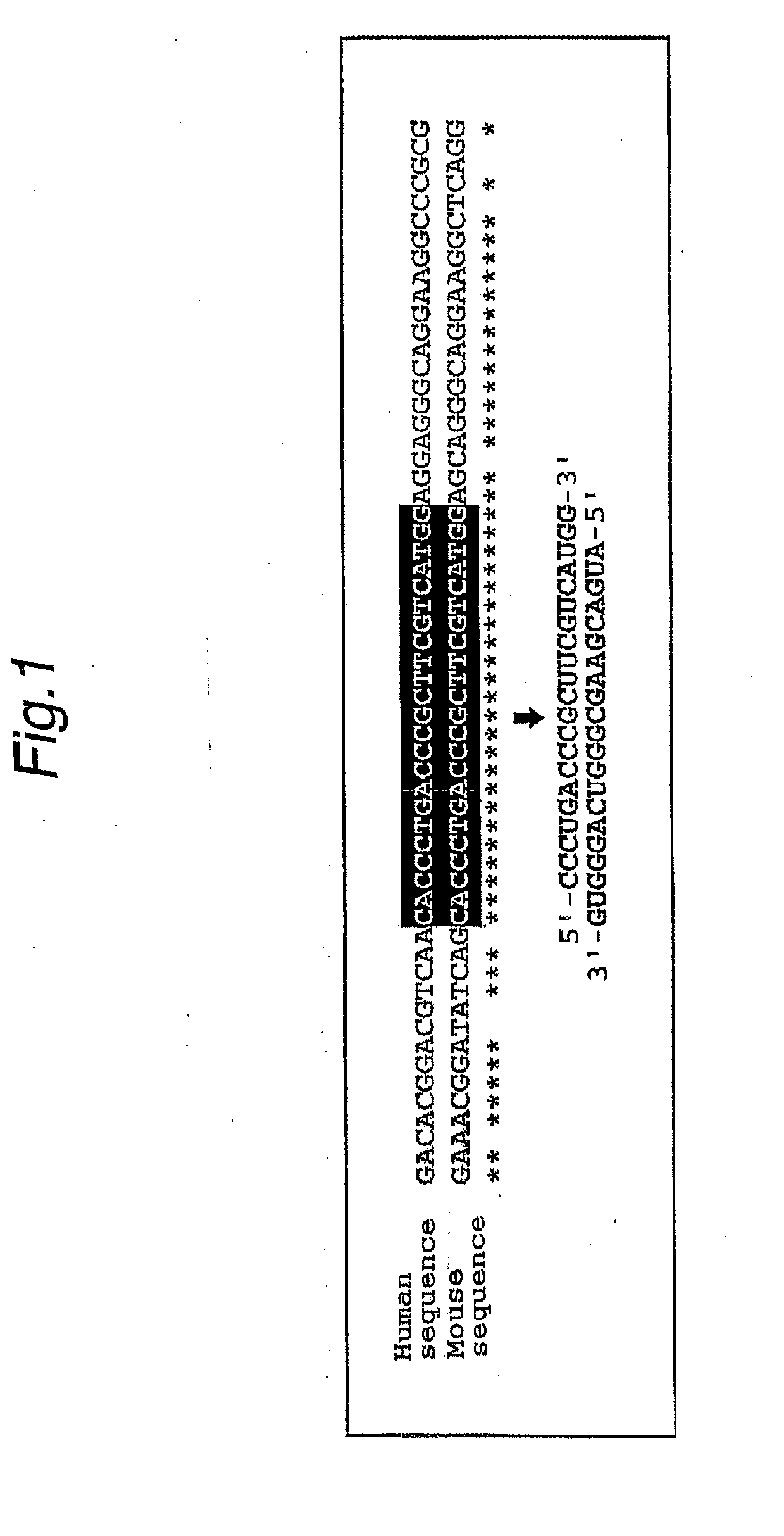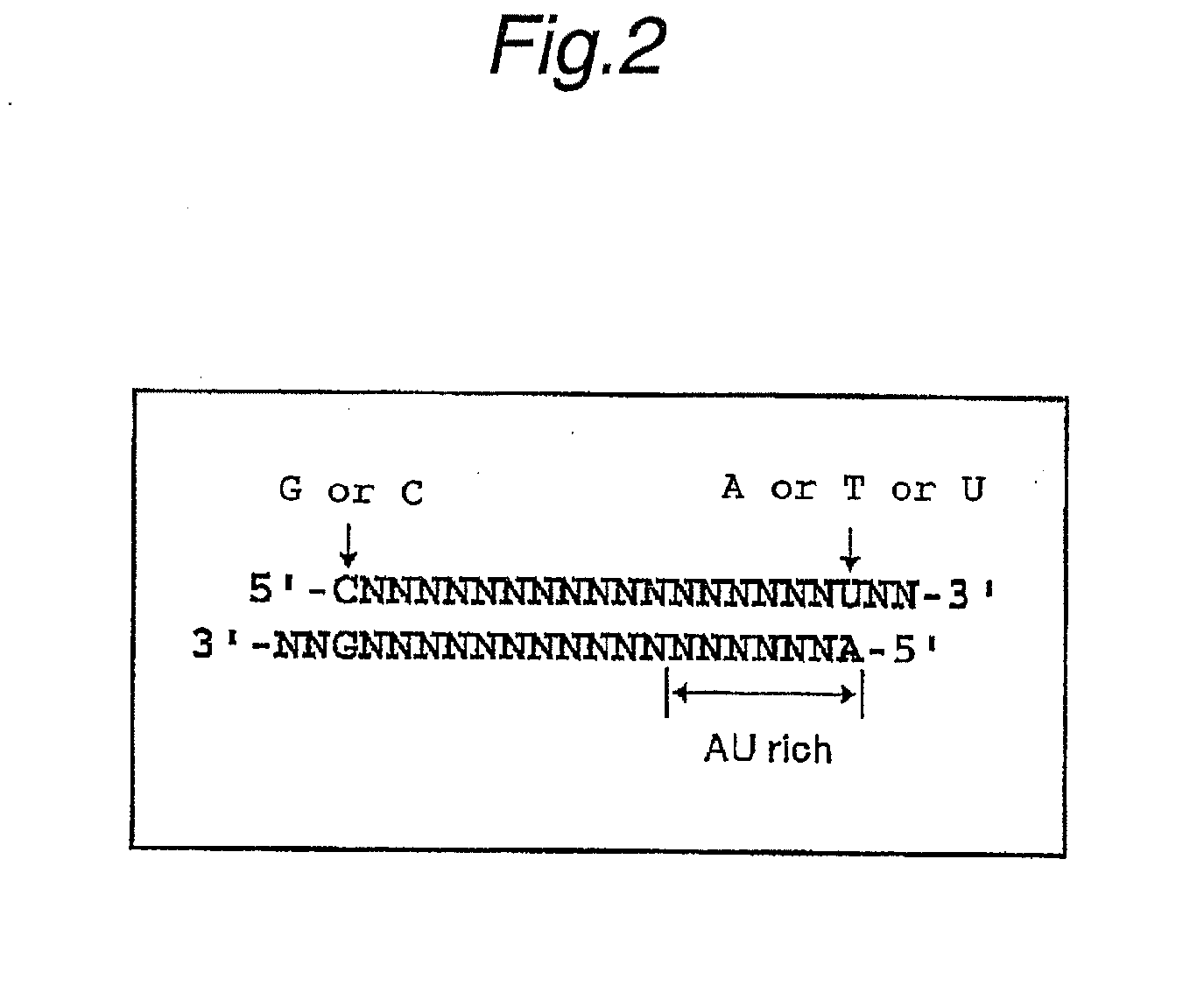Method For Searching Target Base Sequence Of Rna Interference, Method For Designing Base Sequence Of Polynucleotide For Causing Rna Interference, Method For Producing Double-Stranded Polynucleotide, Method For Inhibiting Gene Expression, Base Sequence Processing Apparatus, Program For Running Base Sequence Processing Method On Computer, Recording Medium, And Base Sequence Processing System
a technology of rna interference and target base sequence, applied in the field of rna interference, can solve the problems of cell death and difficulty in applying the rnai method to mammals
- Summary
- Abstract
- Description
- Claims
- Application Information
AI Technical Summary
Benefits of technology
Problems solved by technology
Method used
Image
Examples
example 1
Gene for Measuring RNAi Effect and Expression Vector
[0223]As a target gene for measuring an RNAi effect by siRNA, a firefly (Photinus pyralis, P. pyralis) luciferase (luc) gene (P. pyralis luc gene: accession number: U47296) was used, and as an expression vector containing this gene, a pGL3-Control Vector (manufactured by Promega Corporation) was used. The segment of the P. pyralis luc gene is located between an SV40 promoter and a poly A signal within the vector. As an internal control gene, a luc gene of sea pansy (Renilla reniformis, R. reniformis) was used, and as an expression vector containing this gene, pRL-TK (manufactured by Promega Corporation) was used.
Synthesis of 21-Base Double-Stranded RNA (siRNA)
[0224]Synthesis of 21-base sense strand and 21-base antisense strand RNA (located as shown in FIG. 9; a to p) was entrusted to Genset Corporation through Hitachi Instrument Service Co., Ltd.
[0225]The double-stranded RNA used for inhibiting expression of the P. pyralis luc ge...
example 2
1. Construction of Target Expression Vector pTREC
[0235]A target expression vector was constructed as follows. A target expression molecule is a molecule which allows expression of RNA having a sequence to be targeted by RNAi (hereinafter, also referred to as a “target sequence”).
[0236]A target mRNA sequence was constructed downstream of the CMV enhancer / promoter of pCI-neo (GenBank Accession No. U47120, manufactured by Promega Corporation) (FIG. 25). That is, the following double-stranded oligomer was synthesized, the oligomer including a Kozak sequence (Kozak), an ATG sequence, a cloning site having a 23 base-pair sequence to be targeted (target), and an identification sequence for restriction enzyme (NheI, EcoRI, XhoI) for recombination. The double-stranded oligomer consists of a sequence shown in SEQ ID NO: 1 in the sequence listing and its complementary sequence. The synthesized double-stranded oligomer was inserted into the NheI / XbaI site of the pCI-neo to construct a target ex...
example 3
1. Inhibition of Expression of Endogenous Vimentin by siRNA
[0251](1) Transfection into Cultured Cells
[0252]HeLa cells were seeded at 0.2 to 0.3×106 cells per well of a 24-well plate, and after one day, using Lipofectamine 2000 (manufactured by Invitrogen Corp.), 100 nM of siRNA for VIM (siVIM35 or siVIM812) or control siRNA (siControl) and, as a control for transfection efficiency, 0.5 μg of pEGFP (manufactured by Clontech) were simultaneously transfected according to the manual. pEGFP is incorporated with EGFP.
(2) Assay of Endogenous Vimentin mRNA
[0253]Three days after the transfection, the cells were recovered and total RNA was extracted with Trizol (manufactured by Invitrogen Corp.). One hundred nanograms of the resulting RNA was reverse transcribed by SuperScript II RT (manufactured by Invitrogen Corp.), using oligo (dT) primers, to synthesize cDNA. PCR was carried out using the cDNA product as a template and using primers for vimentin, VIM-F3-84 and VIM-R3-274 (SEQ ID NOs: 11 a...
PUM
 Login to View More
Login to View More Abstract
Description
Claims
Application Information
 Login to View More
Login to View More - R&D
- Intellectual Property
- Life Sciences
- Materials
- Tech Scout
- Unparalleled Data Quality
- Higher Quality Content
- 60% Fewer Hallucinations
Browse by: Latest US Patents, China's latest patents, Technical Efficacy Thesaurus, Application Domain, Technology Topic, Popular Technical Reports.
© 2025 PatSnap. All rights reserved.Legal|Privacy policy|Modern Slavery Act Transparency Statement|Sitemap|About US| Contact US: help@patsnap.com



